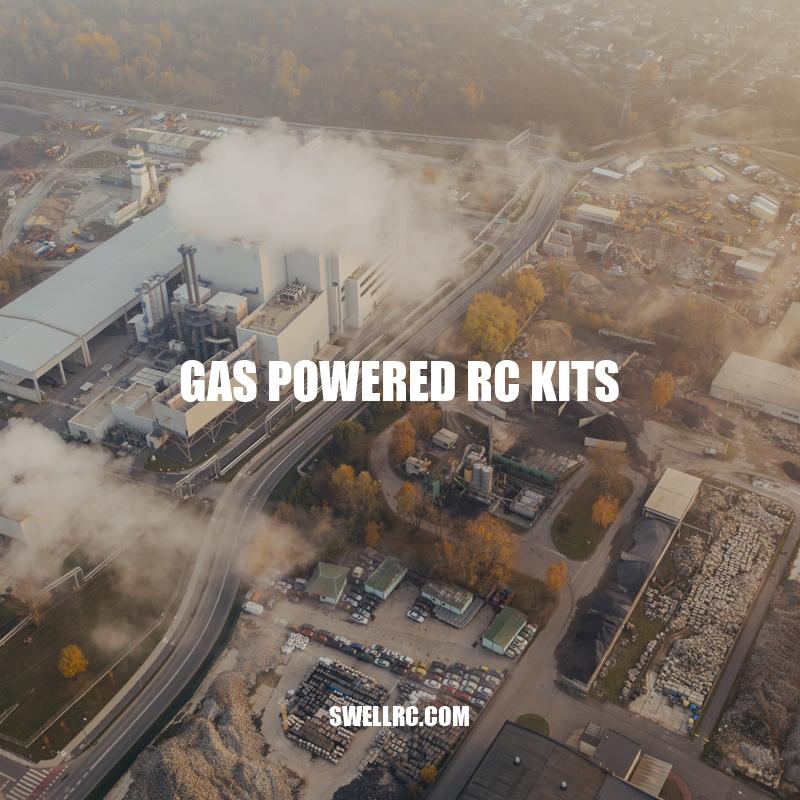Gas-Powered RC Kits: A Guide to Building and Racing with Internal Combustion Engines.
Gas-Powered RC Kits: Everything You Need to Know
If you’re looking for an exhilarating new hobby or just love the thrill of remote-controlled cars and trucks, gas-powered RC kits might be just what you need. These kits allow you to build and control your own vehicle with a miniature internal combustion engine. Unlike electric RC kits, gas-powered RC kits offer more power and longer run times, making them great for racing or just having fun. In this article, we’ll cover everything you need to know about gas-powered RC kits, including what they are and how they work, their benefits and drawbacks, and some popular models on the market. Whether you’re a beginner or experienced remote control enthusiast, you’ll find something to love about gas-powered RC kits. So, let’s dive in and explore the exciting world of gas-powered RC kits!
Gas-powered RC kits are similar to electric RC kits in that they are remote-controlled vehicles that can be built and customized. However, instead of using a battery-powered motor, they use a miniature internal combustion engine fueled by gasoline. Here are some key features of gas-powered RC kits:
Key Features of Gas-Powered RC Kits:
– Twin or four-stroke engine fueled by gasoline
– Higher speed and more power than electric RC kits
– Longer run times, reducing the need for frequent charging
– Various customization options to improve performance and appearance
– Higher price tag than electric RC kits due to the cost of materials and complexity of components
– More maintenance and upkeep required (i.e. oil changes, engine cleaning, etc.)
If you’re interested in purchasing a gas-powered RC kit, there are a variety of models and brands available on the market. Some popular options include:
Popular Gas-Powered RC Kits:
– HPI Racing Baja 5B
– Redcat Racing Rampage XT
– Losi 5IVE-T 2.0
It’s important to do your research and read reviews before purchasing a gas-powered RC kit to ensure it meets your needs and experience level. Websites such as Amazon, Tower Hobbies, and HobbyKing offer a wide variety of gas-powered RC kits and can provide valuable customer feedback and reviews.
How do gas powered RC cars work?
Gas powered Radio Control (RC) cars use a small gasoline-powered engine to run, much like full-sized automobiles. These engines typically use two-stroke internal combustion technology, which means that the fuel is mixed with oil before being ignited. Here’s a brief overview of how these engines work:
- Fuel is drawn into the engine’s cylinder by the movement of the piston as it travels up and down.
- An electric spark ignites the fuel and air mixture, causing a small explosion that drives the piston down.
- The motion of the piston is transferred to the wheels via a clutch and transmission system, allowing the car to move forward or backward.
- The exhaust gases left over from the combustion process are expelled from the engine through a muffler.
Gas powered RC cars can be purchased at hobby stores, toy stores, or online. Popular brands include Traxxas, HPI Racing, and Team Associated.
Benefits and Drawbacks of Gas-Powered RC Kits
Like any RC kit, gas-powered RC kits have both benefits and drawbacks. Here are some of the most notable ones:
Benefits:
- More power and speed than electric RC kits
- Longer run times
- Customizable with a variety of engine and parts upgrades
- Ability to imitate real-world vehicles for added excitement
Drawbacks:
- Higher price tag due to cost of materials and complexity of components
- More maintenance and upkeep required than electric RC kits
- Louder and emit fumes, not suitable for all environments
It’s important to keep these benefits and drawbacks in mind when deciding whether a gas-powered RC kit is right for you.
Interestingly, gas-powered RC kits have been around for over 70 years, with the first commercially available RC kit being the Dooling Brothers’ 1937 “Zephyr” gas-powered car. Since then, gas-powered RC kits have evolved to become even more powerful and customizable.
If you’re new to gas-powered RC kits, it can be overwhelming to choose the right one for you. One helpful resource is RCTech.net, a forum for RC enthusiasts that includes sections specifically for gas-powered RC kits. The site has reviews, articles, and guides to help you find the right kit for your needs and preferences. Additionally, many popular gas-powered RC kits have their own dedicated websites, such as HPI Racing and Losi, which can provide valuable information and customer support.
Here is an example of a popular gas-powered RC truck, the Traxxas T-Maxx 3.3:
Traxxas T-Maxx 3.3:
| Feature | Description |
|---|---|
| Engine | Powerful TRX 3.3 racing engine with EZ-Start electric starting system |
| Transmission | Auto-shifting 2-speed transmission with reverse |
| Suspension | 8 oil-filled shocks with long-travel suspension |
| Tires | Large, aggressive tires on 3.8″ chrome wheels |
Is a Gas RC Better Than Electric?
Choosing between gas and electric-powered remote-control (RC) vehicles depends on personal preferences. Here are some factors to consider:
Gas RC Pros
| More Power | Less Weight | Longer Run Time |
| Realistic Engine Sound | Easier to Refuel | Less Maintenance Cost |
| Higher Top Speeds | Better for Racing | More Durable |
Electric RC Pros
- Quiet and Clean
- Easy to Maintain
- Environmentally Friendly
- Less Expensive to Run
- Good for Beginners
- Smaller and Lighter
There is no straightforward answer, but gas RC vehicles are generally well-suited for experienced hobbyists who enjoy tinkering with engines, while electric RCs are better suited to beginners who prefer simpler vehicles or indoor racing.
You can find both gas and electric RC vehicles at websites such as HorizonHobby.com or TowerHobbies.com.
If you’re interested in purchasing a gas-powered RC kit, here are some popular options to consider:
HPI Racing Baja 5B
- 1/5 scale buggy, perfect for off-road racing
- Durable aluminum frame and chassis
- Powerful 2-stroke engine with a top speed of over 40 mph
Redcat Racing Rampage XT
- 1/5 scale monster truck, great for bashing
- Premium 2-stroke engine with high torque and acceleration
- Adjustable oil-filled shock absorbers and large all-terrain tires for maximum handling
Losi 5IVE-T 2.0
- 1/5 scale short course truck, ideal for racing or general off-road driving
- Reliable 2-stroke engine with excellent power and acceleration
- Four-wheel drive and large-capacity fuel tank for longer run times
It’s important to note that these kits can be expensive, with prices ranging from $700 to over $1000, depending on the kit and any optional upgrades you choose. It’s also important to do your research ahead of time to ensure the kit you select fits your experience level and preferences.
If you’re looking to save some money, consider purchasing a used gas-powered RC kit from a reputable seller. Websites like Craigslist and eBay often have listings for used RC kits in excellent condition. However, always exercise caution when making online purchases and make sure the seller has positive reviews and a good reputation.
In addition to purchasing a kit, you will also need to purchase fuel, oil, and other maintenance supplies. Websites like NitroRCX.com and Tower Hobbies offer a variety of RC supplies and parts for gas-powered RC kits.
What are gas powered RC cars called?
Gas powered RC cars are also known as nitro RC cars. These cars are powered by a mixture of nitromethane and methanol, which gives them a realistic sound and feel. Nitro RC cars can be found on websites like Horizon Hobby and Tower Hobbies. Some popular nitro RC car models include the Traxxas Nitro Slash and the HPI Racing Nitro RS4 3 Evo+. If you’re looking for a fast and thrilling remote-controlled car experience, a nitro RC car might be just what you need.
| Pros | Cons |
|---|---|
| Realistic sound and feel | Can be expensive |
| Higher speed and power than electric RC cars | Requires fuel and oil to operate |
| More challenging to tune and maintain | Creates fumes and noise pollution |
Gas-Powered RC Kit Maintenance Tips
While gas-powered RC kits offer more power and longer run times than electric kits, they also require more maintenance to keep them running smoothly. Here are some tips to keep your kit in top condition:
Regularly Clean Your Kit
After each use, make sure to clean your RC kit to prevent dirt and debris from building up in the engine or other parts. Use compressed air or a soft brush to remove any dirt or debris.
Change the Oil Regularly
Just like a real car, gas-powered RC kits require regular oil changes to keep the engine running smoothly. Check the manufacturer’s instructions for how often to change the oil and what type of oil to use.
Tighten Screws and Nuts
Before each use, check that all screws and nuts are tight and secure. Loose screws or nuts can cause damage to the kit and affect its performance.
Store Your Kit Properly
When not in use, store your RC kit in a cool, dry place to prevent damage from moisture or sunlight. Cover the kit with a sheet or towel to keep dust or debris from collecting on it.
With these simple maintenance tips, you can keep your gas-powered RC kit running smoothly and enjoy it for years to come. Remember to always read the manufacturer’s instructions and consult with an expert if you have any questions or concerns.
Final Thoughts
Gas-powered RC kits offer a thrilling and exciting hobby that can be tailored to your personal preferences and skill level. While they come with higher costs and require more upkeep than electric RC kits, their power and speed make them worth the investment for many RC enthusiasts. With the right kit, proper maintenance, and safe handling, you can enjoy the excitement and customization options of a gas-powered RC kit for years to come.



